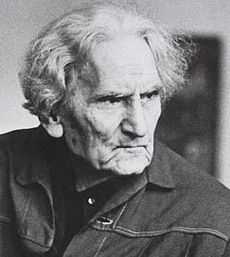Martiros Saryan
| Martiros Saryan | |
|---|---|
 | |
| Born |
28 February [O.S. 16 February] 1880 Nakhichevan-on-Don, Don Voisko Oblast, Russian Empire |
| Died |
5 May 1972 (aged 92) Yerevan, Soviet Armenia |
| Nationality | Armenian |
| Field | Painter |
| Works | "Armenia", "Morning at Stavrino", "Burning Heat with a Dog Running", and "In the Grove at Sambek" |
| Awards |
|

Martiros Saryan (Armenian: Մարտիրոս Սարյան) (28 February [O.S. 16 February] 1880 – 5 May 1972) was an Armenian painter.
Biography
He was born into an Armenian family in Nakhichevan-on-Don (now part of Rostov-on-Don, Russia). In 1895, aged 15, he completed the Nakhichevan school and from 1897 to 1904 studied at the Moscow School of Arts, including in the workshops of Valentin Serov and Konstantin Korovin. He was heavily influenced by the work of Paul Gauguin and Henri Matisse. He exhibited his works in various shows. He had works shown at the Blue Rose Exhibit in Moscow.[1]
He first visited Armenia, then part of the Russian Empire, in 1901, visiting Lori, Shirak, Echmiadzin, Haghpat, Sanahin, Yerevan and Sevan. He composed his first landscapes depicting Armenia: "Makravank," 1902; "Aragats," 1902; "Buffalo. Sevan", 1903; "Evening in the Garden," 1903; "In the Armenian village", 1903, etc. which were highly praised in the Moscow press.[2]
From 1910 to 1913 he traveled extensively in Turkey, Egypt and Iran. In 1915 he went to Echmiadzin to help refugees who had fled from the Armenian genocide in the Ottoman Empire. In 1916 he traveled to Tiflis (now Tbilisi) where he married Lusik Agayan. It was there that he helped organise the Society of Armenian Artists.
After the Bolshevik seizure of power in 1917 he went with his family to live in Russia. In 1921 they moved to Armenia.[3] While most of his work reflected the Armenian landscape, he also designed the coat of arms for Armenian SSR and designed the curtain for the first Armenian state theatre.
From 1926 - 1928 he lived and worked in Paris, but most works from this period were destroyed in a fire on board the boat on which he returned to the Soviet Union.[4]
In the difficult years of the 1930s, he mainly devoted himself again to landscape painting, as well as portraits. He also was chosen as a deputy to the USSR Supreme Soviet and was awarded the Order of Lenin three times and other awards and medals. He was a member of the USSR Art Academy (1974) and Armenian Academy of Sciences (1956).[5]
Saryan died in Yerevan on 5 May 1972.[6] His former home in Yerevan is now a museum dedicated to his work with hundreds of items on display. He was buried in Yerevan at the Pantheon next to Komitas Vardapet.
Quotes
Nature's ways are wonderful and unfathomable. The grain swells in the soil, the sprout grows and flowers when the time comes and then it bears new fruit and so does not die. We are like grain. We never die because we are One with Nature. To understand this is to comprehend Immortality—the Apotheosis of the Human Race. It is with this conviction that I have lived my Life. My Life is a store of my experience, a Life of aspirations, sorrows, joys and triumphs. (M. Saryan)
Life is an island. People come out of the sea, cross the island, and return to the sea. But this short life is long and beautiful. In getting to know nature man exalts the wonder and beauty of life (M. Saryan)
References
- ↑ 1.0 1.1 словари (1972-05-05). "(in Russian) Biography in Great Soviet Encyclopedia". Slovari.yandex.ru. Retrieved 2013-05-11.
- ↑ "The singer of Armenia" (in Russian). Russia Academy of Sciences. Retrieved 2010-02-21.
- ↑ "Biography, Saryan's Museum". Saryan.am. Retrieved 2013-05-11.
- ↑ "Biography, Saryan's Museum". Saryan.am. Retrieved 2013-05-11.
- ↑ "Saryan". Agniart.ru. Retrieved 2013-05-11.
- ↑ "(in Russian) Biography in Krugosvet Encyclopedia". Krugosvet.ru. Retrieved 2013-05-11.
External links
| Wikimedia Commons has media related to Martiros Saryan. |
- Martiros Saryan
- M. Saryan: Biography, Gallery
- M. Saryan in The Color of Armenian Land
- Saryan, Minas, Parajanov
- Martiros Saryan
|